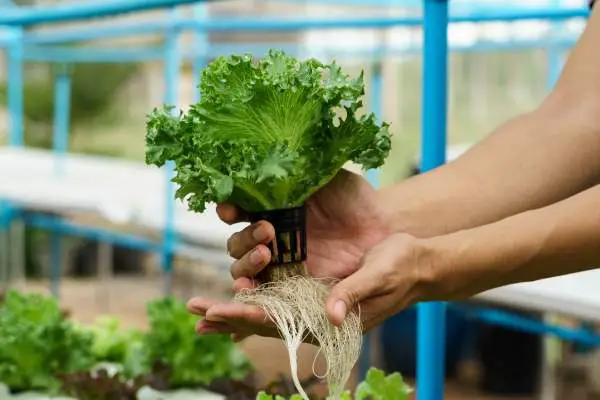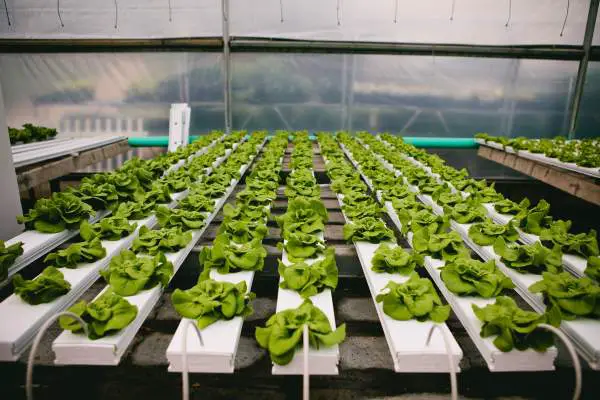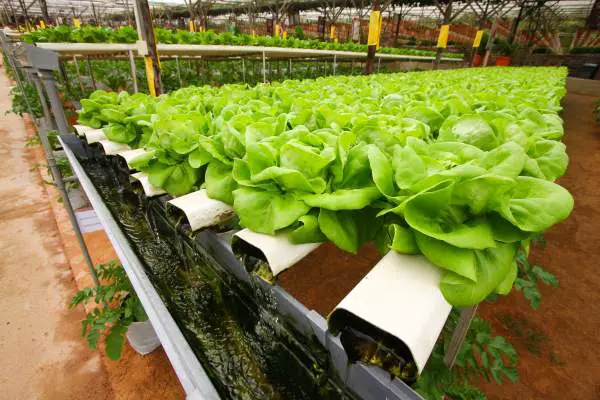Deep water culture systems are among the most accessible and most cost-effective hydroponic systems any gardener can run. The materials required are straightforward, yet there are numerous ways these DWC systems can be built.
It is possible to purchase these systems, but because they are so easy to construct, it is worth any grower’s time to build one and use it as a learning tool for future projects. Here we will run through what exactly is DWC, the advantages, and disadvantages of this system type, and what it takes to build this type of hydroponic system.
Types of DWC Systems
There is the regular DWC system, and this is the one that we will focus on here. There are, however, a couple of other types which are worth mentioning. They are very similar in construction, but with a few minor differences.
Kratky Method
This in construction can be precisely the same as a regular DWC system apart from it not using an air pump. The entire system is passive and has no additional features or equipment.
The way this system works is to leave a gap between the surface of your nutrient mix and the roots. This will be a half-half situation where half of the roots are exposed, and the other half is submerged. As the water levels drop, the roots will grow longer and follow them down.
RDWC (Recirculating Deep Water Culture System)
These recirculating DWC systems are used when there are scaling issues. Regular DWC systems can’t be scaled up efficiently. These work like a cross between DWC and flood and drain systems, but with one difference. The nutrients never drain away from the growing area.
This works by having several containers or buckets that are all connected to a central reservoir. This allows you to scale because it only requires additional buckets to be added. In practice, the oxygenated water passes from the reservoir to each plant in turn before returning back to the reservoir.
In each bucket, there will be sufficient growing space for around 2 or 3 plants depending on the variety. Also, if you have more than this, there may be contention for the nutrients and the oxygen between your plants.
Bubbleponics
This system is exactly the same as a regular DWC system. The only difference is the addition of a water pump. This sits inside the reservoir and pumps the oxygenated water to the top of the net cups where your plants are sitting. This then runs through the growing medium and cascades back into the reservoir.
This type of bubbleponics system is ideal when plants are small, and their roots don’t reach the water in the reservoir. Once they are long enough and can reach the solution by themselves, this type of system holds no benefits over a regular DWC system.
Items Needed to Build a DIY DWC System
- Water and nutrient reservoir
- DWC net pots for holding your plants
- Hydroponics nutrients and pH adjusters
- Air pump and air stones for tank aeration
Here are each of the components in a little more detail:
DWC Reservoir
In a deep water culture hydroponic system, the plant roots will be suspended from above in the net pots. Their rooting systems will reach down to be immersed in the solution. There are systems of this type that can have reservoirs for each plant, or you have numerous plants sharing the same reservoir.
If plants share the same reservoir, it may be challenging to grow different plants together. Single plant reservoirs offer more flexibility and control.
The reservoir can be any dark container that has a lid. In this, you will cut holes large enough to support your net pots. These pots will then be filled with growing medium.
It should be noted that no light should be allowed to get inside your hydroponic garden as this can lead to algae growth, and as the roots will be exposed, they could fall foul of air pruning if the light is there for extended periods.
When you install your air pump, the tubes should be changed to black rather than clear plastic, as this can aid algae growth which will spread further into the tank. You should also check where the lid sits on top of the tank, and if needed it can be sealed with plumbers tape.
One helpful tip that some growers do is to cover the top of the tank with a reflective material. This not only prevents ambient light from heating the tank but also helps to reflect light back on the underside of your plants.
Net Pots for DWC
The difference between net pots and regular pots is they have no solid part, they are instead a mesh where the roots can easily travel to reach the solution that is underneath them. You can make your own net pots, but because these are so cheap, you are better off sticking to net pots that you can purchase.
Your pots will also be the placeholder for your inert growing medium that has low water retention properties. Clay pebbles (Hydroton) are ideal for this as they allow maximum airflow to reach the roots. Before planting into these, you will need to germinate your seeds. These are more likely to be in Rockwool cubes which you can transfer once they are large enough.
Note: When you first transplant your seedlings, there is no way the roots will be long enough to reach the solution in the reservoir. For the first few days, you will need to top-water your plants.
Additionally, you can make sure your Rockwool cubes are touching the surface of the nutrient solution. This way they can wick the water up until the roots can take directly from the surface.
Hydroponic Nutrients
With a DWC hydroponic system, you will need to keep an eye on your pH levels. The range should be between 5.5 and 6.5, with the ideal reading being 5.8. One advantage to a DWC system is you can actually use fewer nutrients than in other types of systems, but all the while, you do need to carefully monitor the pH levels.
This is where your pH UP and your pH Down come into play.
One other thing to note is your EC/ ppm levels, as these will let you know the concentrations of your nutrients. This will be crucial when you are learning when to flush the system. When you understand your plant’s requirements, you may find you can go through an entire grow without changing the solution, and topping off the reservoir will only depend on the number of nutrients they are using.
DWC Aeration
Plants need oxygen to grow, and although they will receive some through the clay pebbles, it will not be enough to support them. Air pumps can be one of the most crucial elements of any DWC system. It is advisable to choose an air pump that has no less than 2 outlets. This will allow you to place air stones in separate parts of your reservoir to deliver plenty of oxygen.
The type of air pump you choose does need to deliver enough oxygen to the water. A good guide is one that can deliver double the liters per hour of the volume of your reservoir. This means if you have a tank that holds 100 liters, then you need an air pump that can supply 200 liters of air per hour.
It is worthy to note, this air pump will be running around the clock to keep your solution well-aerated. If it fails, then you can see your plants dying quickly.
If you wish to measure the amounts of oxygen in your water, you can purchase a dissolved oxygen meter. The better and more accurate ones are not cheap, and they should be enough to produce as much oxygen as you can rather than measuring the levels you think you have. These devices are more beneficial to commercial growers.
How Does DWC Work?
Plants don’t take too kindly to having their roots submerged in water, and can become suffocated. In a lot of cases, this will lead to death. But why is it different in a DWC system, as the plants have their roots submerged in water 24/7?
The key to their survival is oxygen. This is where the air pump comes into action because it delivers copious amounts of oxygen to the water. In other hydroponic systems, you can also use air pumps, or falling water in a circulating system can add oxygen to the water.
In DWC systems, the plants can take the dissolved oxygen from the water at the same time as they are soaking up the nutrients. This, in fact, helps them to grow much faster than they would if they were in the soil.
To your reservoir, you will add your water and nutrient mix, this will be pH adjusted into the ideal range. Once you have this, you will then have your plants suspended in the net pots which are protruding through the lid of the reservoir.
At this stage, you will be using the air pump, and when choosing the right air pump for your system, make sure you have one that has multiple nozzles. This will allow you to place more air stones, or you can use one pump for multiple reservoirs.
When the roots are long enough to reach the nutrient solution, then their growth can explode.
This works because in the soil, plants need to search out small water pockets, and in a DWC system, everything they need is right underneath them. You may think you have too many air bubbles, when in fact, the more you can have the better it is for your plants.
DWC Pros and Cons
To fully understand how these DWC systems work, it is good to see the pros and cons that come with them.
Pros
- Faster plant growth because of the enhanced uptake of nutrients and oxygen in the water. A good example being lettuce. This can be grown in around 30-days compared to 60-days when grown in soil.
- There are very few moving parts – in many cases, there is only the air pump
- Because the roots are submerged in the nutrient mix, there aren’t as many nutrients or fertilizer required.
- Once a DWC system is up and running, there is very little maintenance required. As there are few moving parts or circulating water, there is nothing that can become clogged or blocked
All isn’t rosy with DWC systems, and they do have some downsides. Luckily though, the upsides outweigh the bad points by quite a considerable amount.
Cons
- In smaller DWC systems, it can be easy to calibrate your nutrients incorrectly, this can be in either direction.
- Should you have a power outage or pump failure, it can be a matter of hours before your plants drown to low oxygen levels.
- You can see wide fluctuations in your nutrient mixes. This can include water and pH levels.
- It can be challenging to maintain an ideal temperature if you are using a none-circulating DWC system.
As you can see, the majority of problem areas come from the lack of air to the solution. If you can prepare for this, then this will reduce the risk of dying plants. Because of this, some growers have backup air pumps in case this happens.
Lighting for DIY DWC Systems
This will depend on where you are running your DWC system. If you have access to sunlight, then the natural periods are more than sufficient. But, if you are growing indoors, this is very different as you need to take into consideration the heat your lighting will be generating.
Supplemental lighting should only be run for a maximum of 16 hours per day because plants need time to rest, and 8 hours of darkness is more than enough.
You do need to consider the combined heat of any pumps and lighting, and the effect it has on your water temperature. It may be the case you need a small chiller unit if you are using HID lights. Depending on your plant type, you may be able to get away with T5 fluorescents as these run much cooler, and might not affect your water temperature too much.
Common Questions Asked About DWC Systems
Which Type of DWC Should I Try First?
If you are an absolute beginner, then it is probably better, to begin with, either a conventional DWC system or if you don’t want to commit straight away, you can try a Kratky system. These types are both straightforward to set up and inexpensive. Although they might appear the most simple in function, they can still deliver excellent yields.
What Nutrients Should I Use In My DWC System?
Many growers decide to use organic forms of nutrients, and while these do produce great results, it is advisable to stick to nutrients that are known to work and can be easily adjusted.
General Hydroponics 3-part set is more than ideal, and they can be easily adjusted to different ratios that will suit a wide range of plants. These are also relatively inexpensive and are well proven to work.
How Deep Should the Roots Go Into the Water?
When you are transplanting your seedlings or topping off your reservoir, you should make sure you only submerge the bare root into the water. The stem of your plants should remain exposed. There should be around 1.5 inches of roots that are outside of the surface of the water.
These exposed parts of the root system allow your plants to take up even more oxygen from the plant’s surroundings.
What Should the Temperature of My Reservoir Be?
As we saw, the temperature can be one of the downsides to DWC systems. If you are growing indoors, and have a circulating system, then the pump will be generating heat as well as heat from your grow lights. If your nutrient mix becomes too warm, it reduces the amount of oxygen in the water. On the other hand, if you are cooling your mixture and it becomes too cold, it can cause plants to have stunted growth.
Surrounding air temperatures should be around 75 – 80F, and the temperatures around the root zone need to be in the range of 60 – 68F for optimum growth.
What is the Ideal pH and EC/PPM For DWC?
The recommended range of the pH level is from 5.5 to 6.5. Although, this will depend on the plant type and the growth stage of your plants.
It is usual for vegetative crops to have pH levels that are in the higher end, while fruits or flowering plants will be requiring a pH level that is at the lower end.
When you start looking at the EC levels, it is advised you mix lower levels of nutrients in DWC systems. There are a couple of reasons for this. First, if your water is none circulating, the concentration is all in one place, and this is directly exposed to your plant’s roots.
Secondly, plants take up more water than they do nutrients so this will enrichen the nutrient content in your solution as levels drop, thus giving a higher EC level. If you add full strength, this can be more harmful to your plants. Adding lower levels won’t necessarily hurt them, it just means they will be working a little harder to absorb what they require.
Conclusion
A DWC system is very easy to set up, be it one that is purchased, or one which is built yourself. The results will be the same, and this is high yields from your plants with minimal effort. Another advantage of a DWC system is that it can be used as a supplemental system if you have spare space, they take so little effort to run that even the smallest of spaces can be used.
Anyone who wishes to try hydroponics is advised to try one of these systems first. There is nothing to lose, but as a grower, there is everything to gain.





